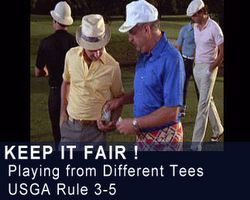| Keep it Fair ! |
| Explanation of USGA Handicap System Section 3-5 - Players Competing from Different Tees (Download Printable Document) |
| The USGA Handicap System is set up so each player converts a Handicap Index to a Course Handicap and plays with the Course Handicap as calculated. Although your decimal figure Index is your “raw” number, you never play with it. You must convert your Index to a whole number in order to use it. | 
|
| If players are competing against each other and a difference in Course Rating exists, an additional adjustment must be made to the Course Handicap of the player playing from the higher-rated set of tees. This player is now playing a harder golf course than the players who are playing a more forward set of tees, and equity will not be created unless a further adjustment is made. By “harder” we are mostly talking about “longer” and yardage is a significant factor of difficulty to overcome. Though giving and taking away strokes can cause emotions to run high and is sometimes hard to accept, a rule is a rule! It’s very helpful to remember that the entire purpose of the Handicap System is to create equity – this provision goes a long way in making sure that happens. |
| We strongly believe that everyone should play the set of tees they are most comfortable playing. If you want to move to a forward tee while playing against your buddy who is playing the back tees, go ahead and do it. Section 3-5 takes care of this situation perfectly. Just make the proper adjustments and enjoy a fair game. |
| It’s helpful to understand the real meaning of Course Rating, especially with this rule. Course Rating represents our benchmark for scratch – that number is the best round that can be expected on that set of tees (fun fact: par is not a benchmark for scratch nor a fair indicator of a course’s difficulty and has little meaning within the Handicap System). When a difference in Course Rating exists among competitors, their benchmarks are now different and this difference must be accounted for in order for the competition to be equitable. |
| There are two options when applying this adjustment, and you need to do just a little bit of math to get the fair result. The rounded difference in Course Rating can be either added to the higher-rated tee players or subtracted from the lower rated tee players, as the practical effect will be exactly the same. The rounding must be completed with any difference of .5 or greater rounded upward. So, if the difference in ratings is 1.2 strokes, this is a one stroke adjustment. If the difference is 2.7 strokes, this is a three stroke adjustment. |
| Please keep in mind that this adjustment is only applied when players are competing against each other. A Handicap Index is a number based on a standard calculation and not specific to any set of tees. You don’t really “establish your Index” from a specific set of tees! A Course Handicap gives a player the number of strokes needed to play down to the Course Rating for a particular set of tees. Conversion to a Slope will equalize the play for the same gender playing the same set of tees only. Once two sets of tees are in play, the extra adjustment must be made. |


